
This and other TeaFeathers development is was funded through my Patreon! Please have a look if you are interested in more world building material. :)
https://www.patreon.com/Eskiworks
Currently Pylura are a CLOSED SPECIES! The Pylura are one of the primary species in TeaFeathers; a race of sapient felines with strong cultural roots in science, metallurgy, and fire! I made this guide as an introduction to the species. Let’s get started!
The Basics
Pylura are between three and four feet tall when standing upright, with some individuals reaching up to five and half feet tall. While they are comfortable on all fours, they spend more time walking upright than their friends the Alecani. Their features are very similar to domestic cats, especially their faces. Large forward facing eyes with slitted pupils allow them to be excellent hunters with superb night vision. Though they do see more colors than a domestic cat, they don’t have the color vision range that Alecani have.
They are extremely flexible and lithe, able to leap far distances and perform great acrobatics. They have an overall more critter-ish appearance to their anatomy, less humaniod. Their shoulders are very narrow and sloped, not wide like a human’s, and they have digitigrade legs. Their grasping hands have retractable claws, which afford them the ability to have fine motor control when not using their claws to hunt or fight.
Colors
Pylura colors depends on which tribe they descend from. There are 12 tribes, all adapted to different geological regions. Pylura in colder regions will shed and regrow their coats in creams and whites for the winter. Coat colors do not deviate from natural mammal colors, such as various blacks, browns, greys, tans, and creams. Skin colors range from pinks, browns and greys, with possible splotches like you would see in a domestic cat.
While the Alecani love to dye their fur and feathers, the Pylura do so very rarely. It can be fashionable in large urban centers to shave patterns into one’s fur, or shave large patches and acquire tattoos.
Pylura’s markings are quite diverse. From stripes to rosettes, any pattern seen on the felines we know can manifest in Pylura.
Diet
Pylura are obligate carnivores, who supplement their diets with some vegetable matter. Favorite foods include fish, birds, and larger game such as deer and elk. Leafy greens and flower blossoms are among their preferred plant foods. They are keen hunters and fishers, at night or during the day. Pylura farm fish and domestic fowl, and while they do grow a lot of their own plant foods, most of their gardening skills go towards growing medicinal plants. With an abundance of wild places, they also have ample space to hunt and forage as well.
Quick Culture Overview
Pylura are extremely curious people, which has worked to their advantage. Where in our world the common saying is “curiosity killed the cat,” in their world it’s “curiosity brings gifts.” An often used mantra among the Pylura is “Inquire and receive.” They are scientists, tinkerers, and students of the world around them. More than any other animal on their world, they alter their environment and explore. They are engineers, architects, and blacksmiths, building the infrastructure that houses their alliance with the Alecani. While they openly share their knowledge and craftsmanship to their allies, they still hold the place for highest excellency among their chosen crafts.
The Pylura are magical beings much like the Alecani, who possess varied elemental magics. However, fire is the primary element associated with the Pylura. It’s possible for Pylura to be born with other types of magic, but very uncommon. Their mastery of fire and inborn curiosity has led them to adopt metallurgy as a common practice. All Pylura children learn their way around the forge, and spend between 1 and 2 years working in the village hearth/forge when they go through puberty.
Like the Alecani, the Pylura often leave offerings to spirits to keep in good standing with them. Worshiping of fire spirits is commons, as is worshiping fish and plant spirits (a commonality with the Alecani). There is usually a patron spirit of fire that resides in the communal forge. This hearth usually sits near the Alecani’s communal center; a large tea tree which houses their own patron tea spirit. The leafy tree stays warm by the hearth through winter months.
The economy is very trade based, valuing spices and tea over most other commodities. In areas with a higher population, a more common currency of metal rings has arisen, sometimes supplemented with rations of salt. The farther into the wild areas you get the less the metal rings are used.
Magic
About one third of all Pylura possess the ability to use magic, usually of a fire type or something related (magma, lightning, etc). Magic in TeaFeathers consists of energy from the spirit world channeled through the individual’s body in an intuitive manner. It manifests in an elemental fashion, in a way that reflects the individual’s personality. Water, steam, air, trees, gemstones, sand, storms, flowers, and things along those lines.
https://www.patreon.com/Eskiworks
Currently Pylura are a CLOSED SPECIES! The Pylura are one of the primary species in TeaFeathers; a race of sapient felines with strong cultural roots in science, metallurgy, and fire! I made this guide as an introduction to the species. Let’s get started!
The Basics
Pylura are between three and four feet tall when standing upright, with some individuals reaching up to five and half feet tall. While they are comfortable on all fours, they spend more time walking upright than their friends the Alecani. Their features are very similar to domestic cats, especially their faces. Large forward facing eyes with slitted pupils allow them to be excellent hunters with superb night vision. Though they do see more colors than a domestic cat, they don’t have the color vision range that Alecani have.
They are extremely flexible and lithe, able to leap far distances and perform great acrobatics. They have an overall more critter-ish appearance to their anatomy, less humaniod. Their shoulders are very narrow and sloped, not wide like a human’s, and they have digitigrade legs. Their grasping hands have retractable claws, which afford them the ability to have fine motor control when not using their claws to hunt or fight.
Colors
Pylura colors depends on which tribe they descend from. There are 12 tribes, all adapted to different geological regions. Pylura in colder regions will shed and regrow their coats in creams and whites for the winter. Coat colors do not deviate from natural mammal colors, such as various blacks, browns, greys, tans, and creams. Skin colors range from pinks, browns and greys, with possible splotches like you would see in a domestic cat.
While the Alecani love to dye their fur and feathers, the Pylura do so very rarely. It can be fashionable in large urban centers to shave patterns into one’s fur, or shave large patches and acquire tattoos.
Pylura’s markings are quite diverse. From stripes to rosettes, any pattern seen on the felines we know can manifest in Pylura.
Diet
Pylura are obligate carnivores, who supplement their diets with some vegetable matter. Favorite foods include fish, birds, and larger game such as deer and elk. Leafy greens and flower blossoms are among their preferred plant foods. They are keen hunters and fishers, at night or during the day. Pylura farm fish and domestic fowl, and while they do grow a lot of their own plant foods, most of their gardening skills go towards growing medicinal plants. With an abundance of wild places, they also have ample space to hunt and forage as well.
Quick Culture Overview
Pylura are extremely curious people, which has worked to their advantage. Where in our world the common saying is “curiosity killed the cat,” in their world it’s “curiosity brings gifts.” An often used mantra among the Pylura is “Inquire and receive.” They are scientists, tinkerers, and students of the world around them. More than any other animal on their world, they alter their environment and explore. They are engineers, architects, and blacksmiths, building the infrastructure that houses their alliance with the Alecani. While they openly share their knowledge and craftsmanship to their allies, they still hold the place for highest excellency among their chosen crafts.
The Pylura are magical beings much like the Alecani, who possess varied elemental magics. However, fire is the primary element associated with the Pylura. It’s possible for Pylura to be born with other types of magic, but very uncommon. Their mastery of fire and inborn curiosity has led them to adopt metallurgy as a common practice. All Pylura children learn their way around the forge, and spend between 1 and 2 years working in the village hearth/forge when they go through puberty.
Like the Alecani, the Pylura often leave offerings to spirits to keep in good standing with them. Worshiping of fire spirits is commons, as is worshiping fish and plant spirits (a commonality with the Alecani). There is usually a patron spirit of fire that resides in the communal forge. This hearth usually sits near the Alecani’s communal center; a large tea tree which houses their own patron tea spirit. The leafy tree stays warm by the hearth through winter months.
The economy is very trade based, valuing spices and tea over most other commodities. In areas with a higher population, a more common currency of metal rings has arisen, sometimes supplemented with rations of salt. The farther into the wild areas you get the less the metal rings are used.
Magic
About one third of all Pylura possess the ability to use magic, usually of a fire type or something related (magma, lightning, etc). Magic in TeaFeathers consists of energy from the spirit world channeled through the individual’s body in an intuitive manner. It manifests in an elemental fashion, in a way that reflects the individual’s personality. Water, steam, air, trees, gemstones, sand, storms, flowers, and things along those lines.
Category Artwork (Digital) / All
Species Unspecified / Any
Size 961 x 1155px
File Size 1.8 MB
Listed in Folders
How do the claws work? On cats in our world, from what I know the claws are attached to the end of the digit, which extends or retracts like this (http://www.yourpetsbestfriend.com/......e9ce970c-800wi). But that doesn't seem to be happening here.
I haven't done exact anatomical diagrams, as with fantasy it's more like "because I want to." Similarly, upright walking animals would likely not have their tail intact. We upright walking humans have our tail bones fused into a cradle structure to support ourselves as we walk, which would not be possible in an animal whose tail bones are not fused (like these guys). There's only so far I'm willing to get into scientific accuracy with this particular creature design and world I'm building, gotta make allowances for imagination! :)

 FA+
FA+





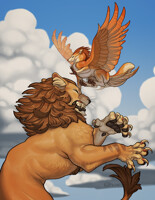

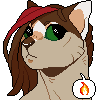
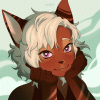


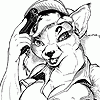

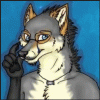
Comments